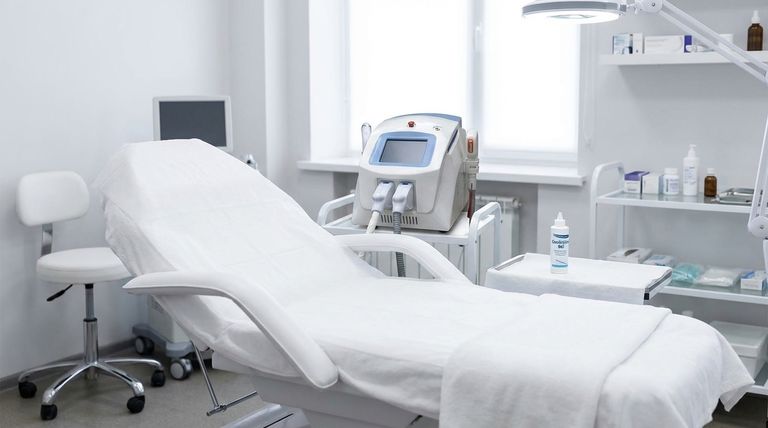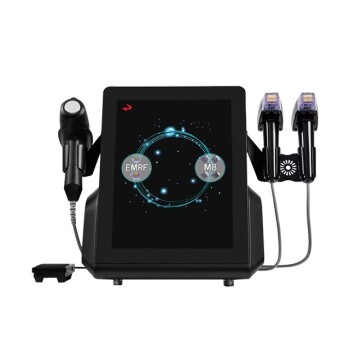Yes, at-home radiofrequency (RF) machines are generally safe for consumer use, provided they are used exactly as instructed. Their design intentionally uses lower energy levels compared to the powerful devices operated by professionals in a clinic. This fundamental difference minimizes the risk of burns and reduces recovery time, making them suitable for a home environment.
At-home RF devices are engineered for safety by operating at a lower power threshold. However, this safety is entirely dependent on correct usage, including following all manufacturer guidelines and understanding the device's limitations.

How At-Home RF Devices Ensure Safety
The safety of consumer-grade RF machines is not accidental; it is a core design principle that separates them from their clinical counterparts. Understanding this design philosophy is key to using them confidently.
The Principle of Lower Energy
Professional RF treatments deliver a high concentration of energy to heat the deeper layers of the dermis, which is why they must be administered by a trained technician. At-home devices are capped at a significantly lower energy output.
This lower energy level is sufficient to stimulate collagen production with consistent use but is intentionally too low to cause the kind of rapid, deep-tissue heating that carries a risk of burns or other tissue damage.
The Critical Role of Conductive Gel
Nearly all at-home RF devices require the application of a conductive gel or primer before use. This gel is not an optional accessory; it is a critical safety component.
The gel ensures that the RF energy is distributed evenly across the skin's surface. It allows the device to glide smoothly, preventing it from lingering in one spot and creating a "hot spot" that could lead to a superficial burn or discomfort.
Built-in Safety Features
Many reputable devices include additional safety mechanisms. These can include integrated temperature sensors that monitor the skin's surface heat and automatic shut-off timers to prevent overuse in a single session.
These features act as a fail-safe, further reducing the risk of user error and ensuring the treatment stays within a safe and effective temperature range.
Understanding the Trade-offs: Safety vs. Efficacy
The design choices that make at-home RF devices safe also create a clear set of trade-offs that every user must understand to manage their expectations.
Lower Energy Means Milder Results
The most significant trade-off for enhanced safety is a reduction in the intensity and speed of results. While professional treatments can produce noticeable tightening after just a few sessions, at-home devices require long-term, consistent use over many weeks or months to yield subtle improvements.
Consistency Is Not Optional
Because the energy stimulus is milder, its effects are cumulative. Skipping treatments or using the device sporadically will likely lead to disappointing results. The effectiveness of an at-home device is directly tied to the user's discipline in following the recommended treatment schedule.
The Lingering Risk of Improper Use
While designed for safety, user error can still lead to negative outcomes. The primary risk is causing minor, superficial burns or redness by holding the device stationary on the skin for too long or by using it without enough conductive gel. Always keep the device moving slowly and continuously across the treatment area.
Contraindications Are Non-Negotiable
These devices are not safe for everyone. Individuals with pacemakers, metal implants (like dental implants or plates in the treatment area), active skin conditions like eczema or rosacea, or a history of skin cancer should not use RF devices. They are also not recommended for use during pregnancy.
Making the Right Choice for Your Goal
Your approach to at-home RF should be guided by your primary objective. Following the correct protocol is the only way to ensure a safe and potentially effective experience.
- If your primary focus is maximum safety: Always perform a patch test, start on the lowest energy setting, and be generous with the conductive gel. Never use the device if your skin feels uncomfortably hot.
- If your primary focus is achieving visible results: Commit to a consistent, long-term schedule as defined by the manufacturer and be patient. Tracking progress with photos can help you see subtle changes over time.
- If you have any medical concerns or sensitive skin: Consult a dermatologist before you purchase or begin using any at-home RF device to confirm it is appropriate for you.
Ultimately, informed and correct use is the foundation of at-home RF safety and success.
Summary Table:
| Safety Feature | How It Works | Key Benefit |
|---|---|---|
| Lower Energy Output | Capped power level compared to professional devices. | Minimizes risk of burns and tissue damage. |
| Conductive Gel | Ensures even energy distribution across the skin. | Prevents hot spots and allows smooth gliding. |
| Built-in Safety Mechanisms | Includes timers and temperature sensors. | Acts as a fail-safe against user error. |
Ready to experience professional-grade results?
While at-home devices offer convenience, professional medical aesthetic equipment delivers more powerful, noticeable, and faster outcomes.
BELIS specializes in professional medical aesthetic equipment, serving medical aesthetics clinics and premium beauty salons. Our advanced RF machines provide superior efficacy and safety under expert operation.
Elevate your treatments and client satisfaction. Contact our experts today to find the perfect professional solution for your business.
Visual Guide

Related Products
- IPL SHR+Radio frecuency machine
- Ultrasonic Cavitation Radiofrecuency Machine for Body Slimming
- RF Microneedling Machine Micro Needle Radio Frequency Machine
- 4D 12D HIFU Machine Device for Skin Tightening and Lifting
- Cryolipolysis Fat Freezing Machine and Ultrasonic Cavitation Device
People Also Ask
- How does an RF machine work? Unlock the Science of Non-Surgical Skin Tightening
- How does SHR hair removal work? A Gentle, In-Motion Technology for Permanent Results
- Is it safe to use RF machine everyday? Avoid These Risks for Optimal Results
- What is the difference between SHR and laser hair removal? Choose the Right Method for You
- How often should I use an RF machine on my face? Optimize Your Treatment Schedule for Best Results



















